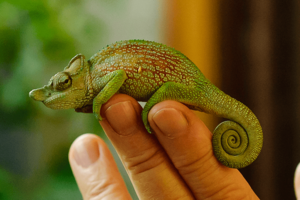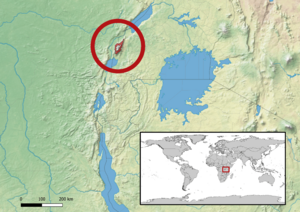Strange-horned chameleon facts for kids
Quick facts for kids Strange-horned chameleon |
|
|---|---|
 |
|
| Young male | |
| Conservation status | |
| Scientific classification | |
| Genus: |
Kinyongia
|
| Species: |
xenorhina
|
 |
|
| Synonyms | |
|
|
The strange-horned chameleon (Kinyongia xenorhina) is a special kind of chameleon. It is also known as the Rwenzori plate-nosed chameleon. This amazing reptile lives in the rainforests of the Ruwenzori Mountains in western Uganda and eastern Democratic Republic of the Congo.
Contents
What Makes It Special?
This chameleon gets its name from a large, unique horn-like growth on its snout. This "horn" is made of two separate plates that grow out from each side of its nose. They then join together at the end. This cool feature is especially big and noticeable on the male chameleons.
It also has a very tall "casque" on its head. A casque is like a helmet-shaped bump at the back of its skull. The head and casque are covered with large, flat scales.
What Does It Look Like?
Strange-horned chameleons can be olive green or brown in color. Males are usually more olive green, while females tend to be browner. They can grow to be about 28 centimeters (11 inches) long from head to tail.
These chameleons have some of the sharpest "teeth" among all chameleon species. They also have very long claws. These features help them survive in their forest home.
Where Does It Live?
The strange-horned chameleon lives in the wet rainforests of the Ruwenzori Mountains. These mountains are found in parts of Uganda and the Democratic Republic of the Congo. They prefer areas with lots of trees and plants where they can hide and hunt.
Protecting This Chameleon
Most of the strange-horned chameleons live inside the Rwenzori Mountains National Park. This park helps protect their natural home. Sadly, many forests outside the park have been cut down. Some parts of the forest inside the park are also being damaged.
Another problem is people sometimes try to catch these chameleons to sell them as pets. Even though this does not happen often right now, it could become a big threat. Because of these dangers, the IUCN (International Union for Conservation of Nature) says this chameleon is "near threatened". This means it could become endangered if we don't protect it. It is also listed in Appendix II by CITES, which helps control trade of animals.


